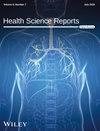Cognitive Impairment Among Chronic Obstructive Pulmonary Disease Patients of Nepal: A Cross-Sectional Study
Abstract
Background and Aims
Chronic Obstructive Pulmonary Disease (COPD) is associated with cognitive impairment, including memory loss, executive dysfunction and attention deficits all of which significantly affect quality of life. However, the prevalence and determinants of cognitive impairment among COPD patients in Nepal remain largely unexplored.
Methods
This cross-sectional study included a total of 203 COPD patients admitted to a tertiary hospital in Nepal between August 2022 and June 2023. Sociodemographic, clinical, and biochemical data were collected from the patients. Cognitive functions were assessed using the Nepali-translated Rowland Universal Dementia Assessment Scale. Logistic regression analysis was conducted to identify factors associated with cognitive impairment.
Results
The mean age of COPD patients was 68.4 ± 10.2 years, with most from the age group 65–75 years, and nearly 2/3rd (63.5%) were females. A majority (62.6%) lacked formal education, and 81.3% were smokers (current or former). Clinically, 45.3% of patients had grade III dyspnea, and 37.9% had pneumonia. Among the patients, 11.8% patients experienced more than five exacerbations in the past year, and 43.4% required more than one hospital admission during the previous year.
Cognitive impairment was prevalent in majority of the patients, with 46.3% exhibiting mild cognitive impairment and 42.9% exhibiting dementia. Factors associated with cognitive impairment included increasing age of COPD patients (≥ 65 years) (OR 2.72; p = 0.003), having more than one COPD exacerbation in a year (OR 3.90; p = 0.002), years of living with COPD (≥ 10 years) (OR 0.47; p = 0.016), frequent COPD exacerbation related hospitalization (OR 0.29; p = 0.004), and lower blood PaCO2 levels (OR 0.26; p = 0.007).
Conclusion
Nearly 90% of COPD patients in Nepal had some form of cognitive decline. Age, exacerbation frequency, and PaCO₂ levels were significant predictors. Routine cognitive screening and targeted interventions like integrated rehabilitation strategies, including pulmonary rehabilitation and oxygen therapy are essential to enhance patient outcomes and reduce disease burden in future.


 求助内容:
求助内容: 应助结果提醒方式:
应助结果提醒方式:


